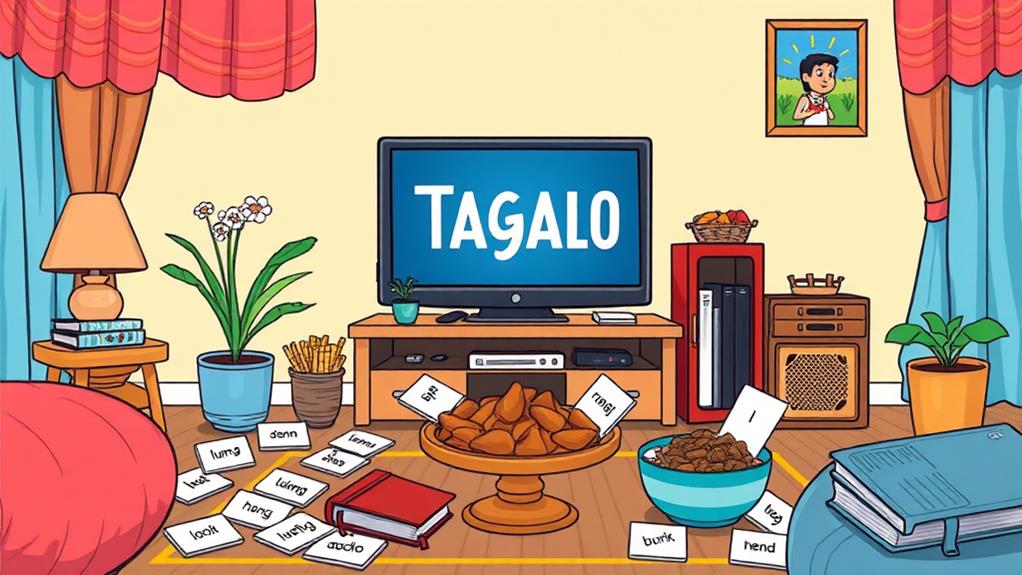Immerse yourself in Tagalog with movies and TV shows to accelerate your language learning. Start by selecting content that features everyday conversations and subtitles to improve vocabulary retention.
Films showcasing different Filipino cultures and dialects, such as "Ang Babae sa Septic Tank" (The Woman in the Septic Tank) or "Honor Thy Father", provide valuable insights into the language's variations.
Popular dramas or comedies, like "Forevermore" or "Ang Probinsyano", offer relatable scenarios and colloquial language that can help you better understand everyday conversations.
Repeat phrases and dialogues aloud to improve your pronunciation and intonation. For instance, watch a scene from a TV show, then repeat the lines out loud to practice your delivery.
Pair TV shows with language lessons to enhance your understanding of the language. Watch an episode, then review the vocabulary and grammar used in the show with your language lessons.
By incorporating these tips into your routine, you'll be well on your way to language fluency.
Selecting Tagalog Content Wisely

Choosing the right Tagalog content is crucial for effective learning. Selecting Tagalog movies and TV shows that feature everyday conversations helps enhance practical vocabulary and improve listening comprehension.
Opt for content with subtitles in both Tagalog and English to facilitate understanding and reinforce vocabulary retention. This way, you can easily look up unfamiliar words and phrases.
Expose yourself to various Filipino cultures and dialects by choosing films or series that portray different accents and regional expressions.
Popular Tagalog dramas or comedies are ideal as they often incorporate relatable scenarios and colloquial language, making learning engaging and enjoyable.
Use streaming platforms like Netflix or YouTube to regularly immerse yourself in the language and stay motivated.
Maximizing Language Learning From Movies
Maximize Language Learning from Movies
Improve Vocabulary Retention and Listening Skills
Watching Tagalog movies with subtitles is an effective way to enhance vocabulary retention and improve listening skills. By connecting spoken words with their written forms, you'll be able to recognize and understand Tagalog vocabulary more effectively.
Learn Natural Speech Patterns and Pronunciation
Engaging with Tagalog movies and TV shows helps you become familiar with natural speech patterns, slang, and cultural references that may not be covered in traditional learning materials.
Repeating phrases and dialogues out loud aids in developing your pronunciation accuracy and intonation, crucial for effective communication in Tagalog.
Understand Conversational Dynamics
Popular Tagalog films or series, such as "Halik sa Hangin" or "On the Job," provide context for language use in everyday situations, facilitating a deeper understanding of conversational dynamics.
Consistently watching Tagalog content creates a passive learning environment, allowing you to absorb the language's rhythm and syntax over time, which can complement your active study methods.
TV Shows for Enhanced Vocabulary

Enhance Your Tagalog Vocabulary with TV Shows
Watching TV shows in Tagalog can significantly improve your vocabulary by exposing you to everyday language and cultural references. This is because TV shows provide conversational phrases, idiomatic expressions, and cultural nuances that help you better understand the language.
TV Shows for Vocabulary Expansion
| TV Show | Vocabulary Benefits |
|---|---|
| Ang Probinsyano, Eat Bulaga! | Everyday language and cultural references that help you understand how Tagalog is used in real-life situations. |
| Pangako Sa 'Yo | Conversational phrases and idiomatic expressions that are essential for effective communication in Tagalog. |
| Iskul Bukol, Pinoy Big Brother | Informal speech, slang, and current colloquial terms that are commonly used in casual conversations.
Maximizing Learning
To get the most out of watching TV shows, pair them with language lessons or language exchange partners to reinforce your understanding of basic Tagalog and Tagalog pronunciation. You can also incorporate TV shows into your daily routine, making them a fun and engaging part of your language learning journey.
Improving Pronunciation With Native Speakers
Improving Pronunciation With Native Speakers
Mastering the correct pronunciation, intonation, and stress patterns of Tagalog can be a significant challenge for many learners. Watching Tagalog movies and TV shows is an effective way to improve your pronunciation by listening to native speakers.
Shadowing native speakers improves pronunciation accuracy and fluency. To do this, repeat lines immediately after the actors to mimic native speech rhythms. This exercise helps you develop a more natural flow and pronunciation.
Using subtitles reinforces understanding of pronunciation. Engage with subtitles in both Tagalog and English to connect spoken words with their written forms. This helps you recognize how words are pronounced and improve your overall understanding.
Exposure to diverse dialects is essential. Regularly watch content featuring different dialects and accents to familiarize yourself with the variations in pronunciation across different regions of the Philippines. For example, the Tagalog spoken in Manila may differ from that spoken in the provinces.
Practicing conversation with native speakers aids retention. Utilize clips of native speakers discussing everyday topics to provide practical examples of pronunciation in context. This helps you retain new vocabulary and phrases more effectively.
Can Self-Study Resources Help When Using Movies and TV to Learn Tagalog?
Watching movies and TV shows is a fun way to immerse yourself in Tagalog, but combining them with the best tagalog selfstudy learning resources enhances your progress. These tools provide structured guidance, helping you decode native dialogue, understand cultural nuances, and reinforce vocabulary, making your language-learning journey more effective and engaging.
Applying Learned Tagalog in Daily Life

Applying Learned Tagalog in Daily Life
After weeks of watching Tagalog movies and TV shows, it's time to put your new phrases and vocabulary to use in your daily life.
Reinforce Retention and Understanding
To reinforce retention and understanding, incorporate the Tagalog phrases and vocabulary you've learned into your daily conversations. Create a routine that includes watching a Tagalog film or series each week, followed by summarizing the plot or discussing themes in Tagalog to practice comprehension and speaking skills.
Daily Plan to Apply Learned Tagalog
| Task | Description |
|---|---|
| Labeling | Label common household items with their Tagalog names to create a constant visual reminder. For example, label your kitchen items like "kape" for coffee, "tinapay" for bread, and "gatas" for milk. |
| Speaking | Set specific daily goals for speaking Tagalog, such as using a new word or phrase in conversation. For instance, aim to use three new vocabulary words in a conversation with a friend or family member. |
| Engaging | Engage with native speakers in casual settings, discussing your favorite shows or movies to practice conversational skills. Try striking up a conversation with a native Tagalog speaker about a recent movie you've watched, using phrases like "Ang gusto ko sa pelikula ay…" (I liked the movie because…).
Frequently Asked Questions
How Long Does It Take to Learn Tagalog Fluently?
It takes around 2 years to learn Tagalog fluently with consistent daily practice and language immersion.
To achieve fluency, focus on building your vocabulary by learning 5-10 new words daily and reviewing them regularly.
Improving your listening comprehension is also crucial, so listen to Tagalog podcasts, radio shows, or TV shows for at least 30 minutes daily.
Practice speaking exercises regularly, such as recording yourself speaking in Tagalog and comparing it with native speakers.
Mastering grammar basics, like verb conjugation and sentence structure, is also essential.
Study and practice correct pronunciation by mimicking native speakers and watching pronunciation tutorials.
Engage in language exchange with native speakers, either in person or online, to improve your speaking and listening skills.
Utilize online resources, such as language learning apps and Tagalog language exchange websites, to expedite your progress.
Stay committed to your daily practice, and you'll be speaking Tagalog fluently in no time.
Can I Learn Tagalog in 3 Months?
Yes, it's possible to learn Tagalog in 3 months. To achieve this, you need to practice consistently every day and use the right strategies.
First, build your vocabulary by creating themed flashcards. Focus on basic phrases, common words, and phrases related to food, transportation, and family. For example, learn the Tagalog words for "hello" (kamusta), "goodbye" (paalam), and "thank you" (salamat).
Next, master the grammar basics. Learn about verb conjugation, tenses, and sentence structure. For instance, understand how to form simple sentences like "I eat rice" (kumakain ako ng kanin) or "She is eating breakfast" (kinakain niya ang almusal).
Improve your pronunciation by doing listening comprehension exercises. Listen to native speakers and try to repeat what they say. You can find many online resources that offer audio clips or videos of native Tagalog speakers.
Immerse yourself in the language by engaging with native speakers through language exchange platforms or social media. This will help you get a feel for how the language is used in everyday conversations.
Watch Tagalog movies and TV shows to get a sense of the cultural context and conversational rhythm. This will also help you learn new vocabulary and phrases in context.
Use interactive apps and media resources to supplement your learning. There are many language learning apps, podcasts, and YouTube channels that offer Tagalog lessons and exercises.
With dedication and the right tools, you can learn Tagalog in 3 months.
Can I Learn Tagalog in a Month?
It is possible to make significant progress in learning Tagalog in a month, but achieving fluency is unlikely.
To make the most of the limited time, focus on immersion techniques, such as listening to native speakers. For instance, watch Filipino movies or TV shows with English subtitles, or listen to Tagalog podcasts. This will help you get accustomed to the sounds, rhythms, and pronunciation of the language.
Vocabulary acquisition is key, and flashcards can be a helpful tool. Create digital or physical flashcards with common Tagalog words on one side and their English translations on the other. Review them regularly to build your vocabulary.
Pronunciation tips from online resources can also be beneficial. Websites like Forvo or YouTube channels dedicated to Tagalog language lessons can provide guidance on correct pronunciation.
Practice methods, such as speaking with conversation partners, either in person or online, will help you apply what you've learned. Additionally, review grammar basics, like verb conjugation and sentence structure, to build a solid foundation.
While it's challenging to become fluent in a month, consistent effort will allow you to develop a solid foundation and build upon it in the future.
How to Become Fluent in Tagalog?
Commit to Consistent Practice and Language Immersion
To become fluent in Tagalog, you need to commit to consistent practice and language immersion. This means dedicating a specific time each day to learning and reviewing Tagalog. For example, set aside 30 minutes each morning to practice speaking, listening, reading, and writing in Tagalog.
Build Your Vocabulary
Building your vocabulary is essential to becoming fluent in Tagalog. Learn 10-15 new words every day by using flashcards, language apps, or reading Tagalog texts. Focus on common words and phrases used in everyday conversations.
Practice Speaking with Native Speakers or Conversation Partners
Practicing speaking with native speakers or conversation partners is crucial to improving your speaking skills. Find a language exchange partner online or in person to practice speaking with for at least 30 minutes a week.
Improve Your Listening Comprehension
Improving your listening comprehension requires regular exposure to Tagalog audio materials. Listen to Tagalog podcasts, radio shows, or TV shows for at least 30 minutes a day to get used to the sound and rhythm of the language.
Master Pronunciation Tips and Grammar Basics
Mastering pronunciation tips and grammar basics is vital to speaking Tagalog fluently. Focus on correct pronunciation by listening to native speakers and practicing with language exchange partners.
Learn basic grammar rules, such as verb conjugation and sentence structure.
Utilize Language Apps and Media Resources
Utilize language apps, such as Duolingo, and media resources, such as YouTube channels, to supplement your learning. Use language apps to practice vocabulary and grammar and watch YouTube channels to learn new phrases and expressions.
Set Achievable Goals
Setting achievable goals helps you stay motivated and track your progress. Set a goal to master a certain number of words each week and review your progress regularly.
With dedication and persistence, you'll be well on your way to fluency in Tagalog.